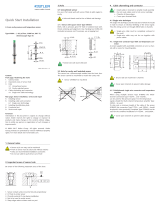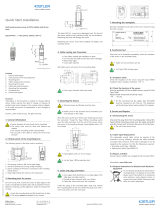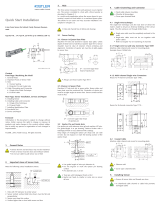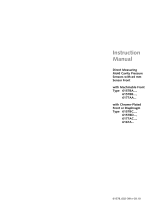
3. Hole
3.1 Unmachined sensor
For use in flat cavity wall with sensor fitted at right angles to
cavity
• Hole and thread must be free of debris and shavings
• Accessories set Type 1300A81 may be used
3.1.1 Sensor with mounting nut Type 6457
Electrical discharge machine (EDM), mill or precision grind H7
hole in hardened tool steel. Check centering and alignment.
Clean thread of debris and shavings.
Quick Start Installation
4 mm Cavity pressure and temperature sensor
Type 6190CA… (–9 pC/bar, 2 000 bar, 200 °C)
(Thermocouple Type K)
1. General notes
• Sensor ø4 mm may not be machined
• Front of sensor must be clean and without notches
• Only use recommended installation accessories
• Do not use cable to pull sensor out of hole
6190C_002-433e-09.17
Content
Front page: machining the mold
1. General notes
2. Important areas of sensor hole
3. Hole
3.1 Unmachined sensor
3.2 Cavity-matched sensor
4. Cable channeling and connector
4.1 Single-wire cable technology
Rear page: sensor installation, service and repair
5. Installing sensor
6. Installing cable and connector
6.1 Single-wire technology
7. Installing identification plate
8. Functional test
9. Service and repair
Foreword
Information in this document is subject to change without
notice. Kistler reserves the right to change or improve its
products and make changes in the content without obliga-
tion to notify any person or organization of such changes or
improvements.
© 2008 ... 2017, Kistler Group. All rights reserved.
1. Sensor contact surface must be flat and perpendicular
2. H7 hole to center sensor
3. Chamfer protects O-ring during installation
4. Not to be used to center sensor
5. Sharp edges reduce witness mark on part
3.1.2 Sensor with spacer sleeve Type 6459
EDM, mill or precision grind H7 hole in hardened tool steel.
Check centering and alignment. Clean thread of debris and
shavings.
2. Important areas of sensor hole
Be aware of the following important areas of the bore:
3.2 Hole for cavity-wall matched sensor
This sensor has a thermocouple welded into the front face.
The sensor cannot be machined to match the cavity wall.
• Sensor CANNOT be machined
4. Cable channeling and connector
• Install cables in channels to simplify mould assembly
• Do not route cables next to hot runner cartridge
• Chamfer all sharp edges
• Cover open channels/slots
4.1 Single-wire technique
The single-wire technique uses the tool steel of which the mould
is made to ensure an electrical shielding of the sensor signal.
Thus the wiring can be run through drilled holes or channels.
• Single-wire cable must be completely enclosed in
the mold
• Single-wire cable may not be run together with
power cables
4.1.1 Single-wire connector Type 1839 and temperature con-
nector
A sensor supplied with assembled connectors is run in a chan-
nel with a recess for mounting plate.
• Ensure radii are machined in channels
• Cover open channels to prevent cable damage
4.1.2 Multi-channel single-wire connectors and tempe ra ture
amplifier
When using multiple Sensors Type 6190CAG and 6190CAG1
the Multi-channel connectors type 1722A4... and 1722A8...
can be used for the pressure signal. For the temperature
signals should the Multi-channel temperature amplifier Type
2205A... be used.
To strip only a minimum length of the cable of the sensor
6190CA... the connectors Type 1722A... and 2205A... should
be placed in close proximity. Frontplate Type 5700A25 can be
used for the combined installation of 1722A4... and 2205A...

5. Installing sensor
• Ensure all sensor hole and threads are clean
• A chamfered cable channel or cable hole prevents
damaged cables
5.1 Sensor installation with mounting nut Type 6457
Install sensor into hole with extraction tool Type 1315A.
Lightly tighten mounting nut Type 6457 with socket wrench
Type 1383. Do not over tighten; sensor may not be pre-
loaded. Ensure a clearance of 0,01 … 0,03 mm.
8. Functional test
On completion of mold assembly, test sensor insulation and
sensitivity.
• Ensure that connector is dry
• Use cleaning spray Type 1003
8.1 Insulation test
Use insulation tester Type 5495 to check sensor insulation.
Resistance >1013 Ω.
8.2 Sensor functional check
Test the sensitivity of the installed sensor using Test Set Type
5495.
Approx. measured value: ±8 % of sensitivity as stated cali-
bration sheet or identification plate.
9. Service and repair
Piezoelectric pressure sensors are maintenance-free. Insulation
and sensitivity of the installed sensor should, however, be
checked after each molding run.
• Ensure that connector is dry
• Cover sensor hole during cleaning
• Use cleaning spray Type 1003
9.1 Insulation test
See chapter 8.1.
9.2 Sensor functional check
See chapter 8.2.
9.3 Removing sensor
Remove sensor with extraction tool Type 1315A or use a flat
ejector pin to press on the sensor front.
• Do not use a hammer on the sensor front
• Do not use a sharp center punch
9.4 Dismounting of cables
Fix Sensor with auxillary tool Type 3.050.175 an detach
cable with fork wrench AF4/AF 5 Type 5.210.164.
9.5 Cable repair
Damaged cables cannot be repaired. Replacement cable Type
2219B... can be ordered from Kistler local sales office.
• Fragile contacts, remove cable only for repair
9.6 Repairs at Kistler
Factory repairs at Kistler are arranged by the local sales office
Information: www.kistler.com
9.7 Disposal instructions for electrical and electronic
equipment
Do not discard old electronic instruments in
municipal trash. For disposal at end of life,
please return this product to an authorized
local electronic waste disposal service or
contact the nearest Kistler Instrument sales
office for return instructions.
• Do not preload sensor
• Take care not to wrap single-wire cable around
socket wrench
• Use extraction tool Type 1315A to install sensor
• Use socket wrench Type 1383 to tighten mounting
nut
5.2 Sensor installation with spacer sleeve Type 6459
Install sensor into hole with extraction tool Type 1315A or
directly with spacer sleeve.
5.2.1 Machining spacer sleeve
Cut spacer sleeve so that it has an overlength of 2 … 3 mm.
Place sensor and sleeve into hole and determine exact length,
ensuring a clearance of 0,01 … 0,03 mm. Sleeve must be
ground so the end is square and planar. Remove any burrs.
For multi-cavity applications each spacer sleeve should be
numbered and allocated to a sensor.
5.2.2 Spacer sleeve and retaining plate
Install sensor and spacer sleeve. Ensure a clearance of 0,01 …
0,03 mm.
Sensor may not be preloaded when assembling the mold.
• Do not preload sensor
• Use extraction tool Type 1315A to install sensor
• For multi-cavity applications each spacer sleeve
should be numbered
Kistler Group
Eulachstrasse 22
8408 Winterthur, Switzerland
Tel. +41 52 224 11 11
Fax +41 52 224 14 14
info@kistler.com www.kistler.com
6190C_002-433e-09.17 Kis120 ©2008 ... 2017, Kistler Group
6.1.1 Cut/grip connection
Cut the single-wire cable to length and do not strip the
insulation. Loosen the knurled connector by hand without
removing the rear section.
When using the temperature amplifier Type 2205A... strip
thermocouple cables. Attach green cable (+) to terminal and
white cable to (–) terminal.
Installation of connector Type 1839 and mounting plate
Installation of multi-channel connector Type 1722A4... and
temperature amplifier Type 2205A...
This installation is for sensor Types 6190CAG... and 6190CAG1
only: A typical installation uses up to 4 sensors.
Assemble 4-channel connector and temperature amplifier in
adapter plate Type 5700A25 and then install in the recess.
6.1.2 Installing single-wire connector and temperature con-
nector with mounting plate
Install connector and mounting plate in recess. Attach cap
using one of the screws. Place caps on open connectors.
• Take care not to damage the gray single-wire cable
when stripping the green sensor cable sheath
• Use sheath stripper Type 1367 to remove green
sheathing
• Refer to Instruction leaflet 002-450
6. Cable and connector installation
• Check again that edges of cable duct are chamfered
• Use a metal plate to cover open channels
• Attach cap and place on connector
6.1 Single-wire technique
• Cables of p/T Sensors consist of one Single-Wire
cable for pressure and two thermocouple braids
• Single-wire cable must be completely enclosed in
the mould
• Single-wire cable may not be ducted together with
power cables
• Ensure that all contact surfaces and threads are clean
and dry
7. Installing identification plate
Rivet plate to side of mold or fit with four M2,5 screws.
p + T Sensor
Type 6189A0,4
SN 1234567
Sensitivity -6,5 pC/bar
Measuring range 2000 bar
Thermocouple Type K
Kistler Instrumente AG
Winterthur Switzerland
Made in Switzerland
25
75
__________________
_______________
_______________
_________________________
_________________________
____________ ___ ___
Kistler Instrumente AG
Winterthur Switzerland
Made in Switzerland
Zeile 1
Zeile 3 Zeile 4
Zeile 6 Zeile 7
Zeile 2 Zeile 5
Zeile 8
Beschriftungsbeispiele:
Schriftart: Helvmed
Schrifthöhe: 1,8mm
Text Laserbeschriftet
äquivalente Schriftart (z.B. Arial) zulässig
Kistler Instrumente AG
Winterthur Switzerland
Made in Switzerland
Force Sensor
Type 9223A0,2
SN 1234567
Sensitivity -4,3 pC/N
Measuring range bar
Measuring pin
Ø
mm
Kistler Instrumente AG
Winterthur Switzerland
Made in Switzerland
Pressure Sensor
Type 6183CCGQ100
SN 1234567
Sensitivity -2,273 pC/bar
Measuring range 2000 bar
ohne Einheitsempfindlichkeit
Pressure Sensor
Type 6157BAE
SN 1234567
Sensitivity -9,4 pC/bar
Measuring range 2000 bar
Kistler Instrumente AG
Winterthur Switzerland
Made in Switzerland
mit Einheitsempfindlichkeit -9,4 pC/bar
Typenschild 75x25x0,5 mit Beschriftung
A4
c
1 / 1
1:1
measure. analyze. innovate.
Erstmals verwendet
Erste Proj.-Nr.
Werkstoff
Änderung
Datum
Massstab
Ersatz für
Kopie Datum
100010525 27.01.2016
gez.
gepr.
ges.
26.01.2016
Beo
Hs
27.01.2016
Hoh
Hs
27.01.2016
100.239.050
Zeichnungs-Nr.
Material-Nr.
KIWAG-SWX_A4h
Ver.
Bl.
9223A__
551456213.0255
55147987
interne und externe Fertigung
Das Urheberrecht an dieser Zeichnung, die dem Empfänger
persönlich anvertraut wird, verbleibt unserer Firma.
Ohne unsere schriftliche Genehmigung darf die Zeichnung
weder kopiert noch vervielfältigt, noch an Drittpersonen
mitgeteilt oder zugänglich gemacht werden.
27.01.2016
100.239.050 - c - YDI - Mat.-Zeichnung - interne und externe Fertigung - Freigegeben --- 55147987 --- 14-Sep-2017 09:48 (CET) - [email protected]
/









